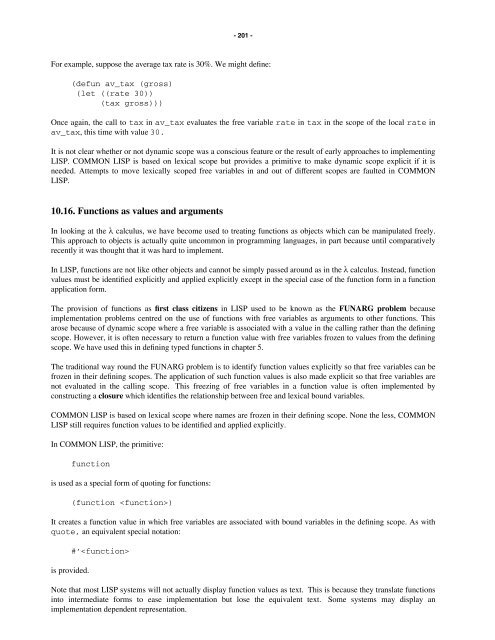An Introduction to Functional Programming Through Lambda Calculus
An Introduction to Functional Programming Through Lambda Calculus
An Introduction to Functional Programming Through Lambda Calculus
You also want an ePaper? Increase the reach of your titles
YUMPU automatically turns print PDFs into web optimized ePapers that Google loves.
- 201 -For example, suppose the average tax rate is 30%. We might define:(defun av_tax (gross)(let ((rate 30))(tax gross)))Once again, the call <strong>to</strong> tax in av_tax evaluates the free variable rate in tax in the scope of the local rate inav_tax, this time with value 30.It is not clear whether or not dynamic scope was a conscious feature or the result of early approaches <strong>to</strong> implementingLISP. COMMON LISP is based on lexical scope but provides a primitive <strong>to</strong> make dynamic scope explicit if it isneeded. Attempts <strong>to</strong> move lexically scoped free variables in and out of different scopes are faulted in COMMONLISP.10.16. Functions as values and argumentsIn looking at the λ calculus, we have become used <strong>to</strong> treating functions as objects which can be manipulated freely.This approach <strong>to</strong> objects is actually quite uncommon in programming languages, in part because until comparativelyrecently it was thought that it was hard <strong>to</strong> implement.In LISP, functions are not like other objects and cannot be simply passed around as in the λ calculus. Instead, functionvalues must be identified explicitly and applied explicitly except in the special case of the function form in a functionapplication form.The provision of functions as first class citizens in LISP used <strong>to</strong> be known as the FUNARG problem becauseimplementation problems centred on the use of functions with free variables as arguments <strong>to</strong> other functions. Thisarose because of dynamic scope where a free variable is associated with a value in the calling rather than the definingscope. However, it is often necessary <strong>to</strong> return a function value with free variables frozen <strong>to</strong> values from the definingscope. We have used this in defining typed functions in chapter 5.The traditional way round the FUNARG problem is <strong>to</strong> identify function values explicitly so that free variables can befrozen in their defining scopes. The application of such function values is also made explicit so that free variables arenot evaluated in the calling scope. This freezing of free variables in a function value is often implemented byconstructing a closure which identifies the relationship between free and lexical bound variables.COMMON LISP is based on lexical scope where names are frozen in their defining scope. None the less, COMMONLISP still requires function values <strong>to</strong> be identified and applied explicitly.In COMMON LISP, the primitive:functionis used as a special form of quoting for functions:(function )It creates a function value in which free variables are associated with bound variables in the defining scope. As withquote, an equivalent special notation:is provided.#’Note that most LISP systems will not actually display function values as text. This is because they translate functionsin<strong>to</strong> intermediate forms <strong>to</strong> ease implementation but lose the equivalent text. Some systems may display animplementation dependent representation.
















